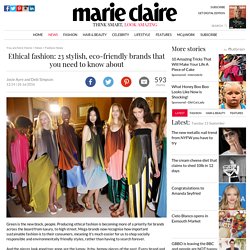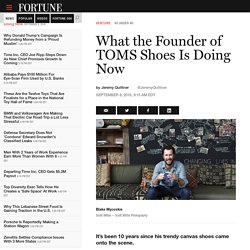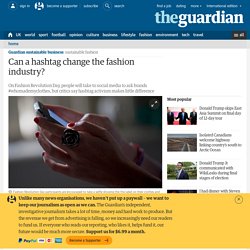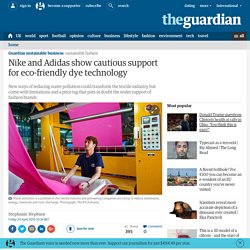

The Best Ethical Fashion Brands. What: Fat Face has a company-wide Code of Conduct where all factories that produce their goods must abide by as well as working with suppliers and other organizations to make sure their workers are treated fairly.

What: Your new one-stop shop for ethically made wedding wear, Minna describes itself as an ‘Eco Luxe’ brand. With wedding dresses, veils and bridesmaid dresses made from sustainable, organic, recycled and locally produced textiles, you can dress your whole wedding party without feeling guilty. What: Worn by Kate Middleton, Mirabelle makes handmade fair trade jewellery as well as a British Made collection. Think pretty pendants at good prices. Wear: Hammered pendant, £69 What: Committed to ethical trading, Monsoon’s ethical compliance team regularly checks that their factories are abiding by its Code of Conduct which sets out minimum requirements on working conditions, pay and employment rights. What TOMS Shoes Founder Blake Mycosckie Is Doing Now. A decade ago, Blake Mycoskie turned two important observations from his travels in Argentina into what would become a multimillion-dollar shoe business.

The first was that impoverished children without shoes were not only exposed to illnesses, but unable to attend school in that country, as shoes are a requirement for attendance. The second was that nearly everyone with shoes, from farmers to cafe goers, was wearing a traditional canvas slip-on called the alpargata. Believing there’d be a market for the shoe in the U.S., Mycoskie, a 2011 alumnus of Fortune’s 40 Under 40 list, soon put two and two together and launched TOMS, short for “Tomorrow’s Shoes.” His plan was to donate a pair of shoes to a needy child for every one he sold, considered by many a groundbreaking model for social entrepreneurship at the time.
He started out with just one business partner named Alejo Nitti, who helped him produce his initial run of shoes, using small shoe makers in Argentina. What did you learn as CEO? How can the fashion industry become more sustainable? Stella McCartney: Change Agent. LONDON, United Kingdom — In a nondescript building tucked away on a quiet street in West London, Stella McCartney and her team are comparing the properties of a real leather shoe to the various non-leather swatches being considered for her brand’s Winter 2015 shoe collection.

McCartney is wearing a cream blouse, open at the neck, with faded blue jeans and non-leather boots. Pinned up against the wall are boards labeled: “Heels,” “Mules,” and “Cutouts.” A large white table is scattered with moulds, lasts and uppers – as well as scissors, ID cards, empty glasses and a partially-eaten package of organic dark chocolate. Women of differing ages, ethnicities and body types come in and out of the room with a constant flow of new ideas and creative references while McCartney acts as a kind of real-time editor, deciding what colours, materials and shapes feel right for the upcoming season. Stella's Sustainability Commitments | Source: BoF At this point, McCartney turns to me, a fly on the wall. Can a hashtag change the fashion industry? Now in its second year, Fashion Revolution Day (FRD) is a hashtag campaign designed to keep the most vulnerable in the fashion supply chain in the public eye.

Held on the anniversary of the Rana Plaza factory collapse in Bangladesh, participants are encouraged to take a selfie showing the label on their clothes and ask the designer or brand #whomademyclothes. It’s an important cause, but can a hashtag campaign really bring meaningful change to the fashion industry? Ruth Stokes, author of The Armchair Activist’s Handbook, says if a campaign is able to raise awareness and reach people otherwise not engaged, then it has provided something of value. The challenge is translating that increased awareness into real-world practical actions, whether that means changing individual behaviors or the laws made by politicians. FRD has changed the hashtag this year to #whomademyclothes after Pixar took over #insideout in anticipation of the Disney animation film Inside Out.
#whocares #meaningfulchange. Nike and Adidas show cautious support for eco-friendly dye technology. It has been a significant step forward for the textile sector.

Up until now the effluent from dye houses that can often be seen in rivers flowing through the textile manufacturing areas of India, China and elsewhere is a result of unabsorbed dyes, chemicals and heavy salts that are used during the dyeing process. A number of companies, DyeCoo, ColorZen and AirDye have set out to address this pollution by designing waterless dye technology. The result is a reduction in wastewater, energy, chemicals and toxic discharge to such a degree that it could revolutionise the textile industry.
Major brands including Nike and Adidas have been integrating waterless dye technologies into their product lines, but costs and limitations have experts in the textile industry worried that the support will not last. “Right now there is very low uptake of use of these technologies,” says Andrew Filarowski, technical director at Society of Dyers and Colourists. The technology The price tag The limitations.